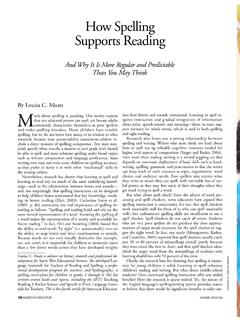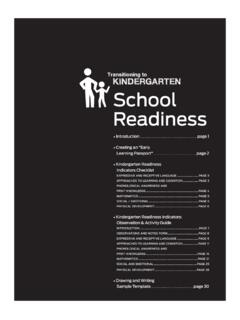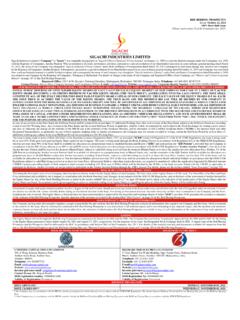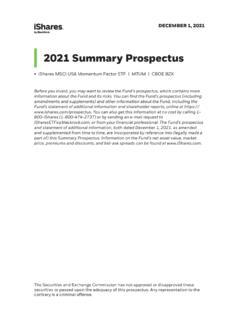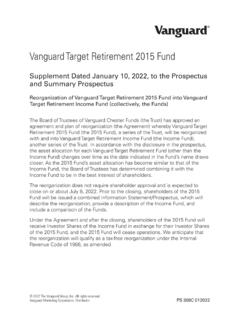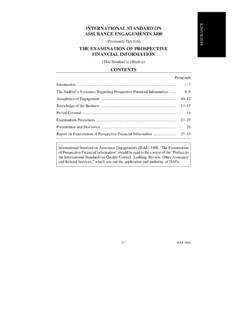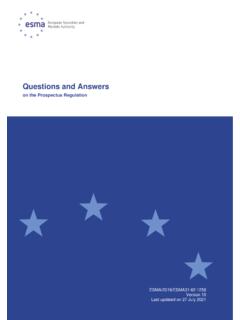Transcription of How to Find Financial Information on Hospitals
1 March 2015. How to find Financial Information on Hospitals The ease of finding Financial Information on a hospital depends on a few factors, including the size and type of hospital ( , critical access, public, private for-profit, public for-profit, etc.). and location. In general, large nonprofit Hospitals are the easiest to research, and private for- profits are the most difficult. Several states periodically collect and analyze Financial and operational Information on Hospitals . Connecticut, for example, requires all Hospitals in the state to submit audited Financial documents and several other standardized forms with Information on patient volume, payer mix, operations, holdings, and even the top 10 highest paid employees. Vermont has a state regulatory agency whose duty it is to set parameters, review, and approve hospital budgets, giving the public access to the budget documents and an opportunity to voice concerns.
2 On the west coast, Oregon collects quarterly Financial and utilization summaries for every hospital in the state, providing the public with up-to-date Information on the Financial performance of Hospitals in state. But every state is different, and some states do next to nothing. The range of transparency and regulation is vast. As a result, it's critical to gain familiarity with your state's healthcare regulatory bodies and the Information they collect from providers, because they are often the most reliable and up-to-date sources. If your state does not collect this Information , there are several other open sources available. This document outlines five reliable sources for obtaining Information on hospital finances, operations, and nurse wages. Source Cost Large Nonprofit Hospitals : EMMA Free All Nonprofit Hospitals : GuideStar Free All Hospitals : Google Operator Search Free Public For-profit Hospitals : EDGAR Free All Hospitals : CMS Cost Report $2,000 per year RN Wages for Most Hospitals : CMS Enclosed Research & Strategic Initiatives 1.
3 March 2015. Large Nonprofit Hospitals : Electronic Municipal Market Access ( EMMA ). system (FREE). EMMA is the best source of Financial Information for large nonprofit Hospitals . Best of all, it's free to the public. Nonprofit Hospitals raise capital by selling debt (tax-exempt bonds), and these financing agreements contractually require Hospitals to periodically submit a wealth of Information for bondholders audited Financial statements, the bond contract itself (called the official statement or bond prospectus ), and continuing disclosure documents. How to navigate EMMA: 1. Visit 2. Click Browse Issuers on the top tool bar. 3. Locate your state and click on it. 4. Immediately above the list of issuers, there is a find in results: search box. Enter the name of your state's bond issuing authority. The names of these agencies usually sound something like Educational and Health Buildings Financing Agency/Authority.
4 I usually shorten the list by entering the term health. Click on the appropriate issuer. 5. Similarly, on the next page, locate the find in results: search box. Enter the name of the hospital you're researching. Your search term will narrow the results. Choose the most recent result ( , the bond). 6. You should now see Information for this particular bond. The tabs Official Statement . and Continuing Disclosure will lead you to the most relevant Financial Information . All Non-profit Hospitals : GuideStar (FREE). Because they are exempt from taxes, the IRS requires all nonprofit organizations to submit forms justifying the tax exemption. Nonprofits must demonstrate that they provide a community benefit. The form nonprofits submit to demonstrate they provide a community benefit is called the IRS 990 form. The 990 is a valuable source of Information , but as a rule of thumb, audited Financial statements are more accurate and comprehensive.
5 However, organizations frequently append audited Financial statement to the bottom of the 990 form, so be sure to check. Visit and register to gain access to the 990 forms. The free account allows users to access the previous five years of 990s. The site is very user-friendly; simply enter the name of the nonprofit organization you are researching into the search box and locate the organization you're looking for among the list of results. Once you find your organization, click the Forms 990 and Docs tab to download the Form 990 PDFs. Research & Strategic Initiatives 2. March 2015. All Hospitals : Google Operator Search Search operators are a useful tool for scouring a website for the Information you want. Instead of endlessly navigating a website hoping to stumble upon the documents you're looking for, you can tailor your search using operators to extract the relevant documents and pages.
6 It's far from universally effective, but it seems to work about a quarter of the time. 1. Say we want to search for the audited Financial statements for the University of Vermont Medical Center. The domain name is 2. Use the operators site: and to locate the documents. Site: tells google to search within the domain name following the colon, and the quotes tell Google to search for the exact phrase in between the quotation marks. In the example below, the first result contains the 2013 and 2012 audited Financial statements (the hospital used to be called Fletcher Allen). 3. You can also try the operator filetype: if you want to narrow your results even further. After the colon, enter the file type you want. Audited Financial statements are typically stored in PDF format, so you would add filetype:pdf to the end of the search string in the screenshot below. Public For-Profit Hospitals : EDGAR.
7 Public for-profit companies (and some private for-profits) are required to make periodic submissions to the Securities and Exchange Commission. EDGAR is an electronic database of these SEC filings. Three forms are worth noting, although there are many others. Companies file Form 10-K annually to inform investors of company finances and operations. Form 10-Q. contains similar Information to the 10-K but is filed quarterly. Form 8-K is filed when the Research & Strategic Initiatives 3. March 2015. company experiences a major event such as an acquisition, bankruptcy, or a change in management, among other things. 1. To find these documents through EDGAR, visit 2. Scroll down to EDGAR Search Tools. If you know the Company's name or ticker symbol, click on Company or Fund Name, ticker symbol, CIK, file number, state country, or SIC.. 3. On the following page, enter the Company's name in the search engine.
8 4. Click on the appropriate company and then choose which document(s) to view. All Hospitals : CMS Cost Reports ($2,000/year). Most Hospitals submit annual Medicare Cost Reports to the Centers for Medicare and Medicaid Services (CMS). CMS uses the Information to set reimbursement rates and reimburse Hospitals for the cost of providing care to Medicare beneficiaries. Cost Reports can be a valuable source of Information , but most people find them more difficult to navigate than audited Financial statements or Form 990s. contains a database of current and old cost reports. A subscription currently costs $2,000 per year. The search tool is straightforward. 1. On the homepage, click Single Cost Reports . 2. The next page allows you to enter several search terms. Usually entering the hospital name and state will yield the appropriate result. RN Wages for Most Hospitals : CMS. Every three years, CMS administers a survey of hospital wages used to adjust reimbursement rates, called the Occupational Wage Mix Survey.
9 The survey was last administered in 2013. The survey covers about 3,000 hospital ; critical access Hospitals , public Hospitals , and specialty Hospitals are excluded because they are reimbursed using a different methodology. The survey asks Hospitals about total salaries and hours worked for several different job categories: RNs; LPNs and Surgical Technologists; Nurse Aides, Orderlies, and Attendants;. Medical Assistants; and other non-nursing occupations. The most important data point is the (weighted) average hourly wage. This gives us the average amount paid by the hospital for an hour of worker time (by job category). In the enclosed data file, the average hourly wage for RNs, for example, is labeled . Research & Strategic Initiatives 4. March 2015. What's included the weighted average hourly wage, you ask? The following screenshot is pulled directly from the survey. The answer: almost everything.
10 The full survey is also enclosed for reference. How to navigate the data file: 1. Narrow the list of results by filtering by state. To do this, click on the icon in the first row, which will cue a drop down list. Click on select all to deselect all states, and then click on the state(s) you want. Click OK. 2. If you're looking for RN wages, for example, the three relevant columns are labeled RNSAL, RNHR, and RNAHW. RNSAL has the total salaries paid to RNs in calendar year 2013. RNHR has the total hours RNs worked in calendar year 2013. RNAHW is simply RNSAL divided by RNHR. 3. If you want to sort the Hospitals by RNSAL, RNHR, or RNAHW, you can do so by clicking on the down arrow for that term, like in the example above. Click on sort largest to smallest or sort smallest to largest to create an ordered list. Research & Strategic Initiatives 5.





